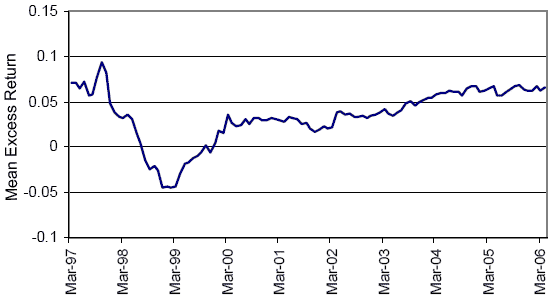Can quantitative analysts replicate the statistical performance of a given hedge fund using a set of easily tradable assets, thereby: (1) recreating the “hedge” as a transparent, liquid and cheap trading system; and, (2) establishing benchmarks truly applicable to specific hedge fund performance? In their June 2005 paper entitled “Hedge Fund Returns: You Can Make Them Yourself!”, Harry Kat and Helder Palaro describe and illustrate a statistical fund replication process. In their February 2006 paper entitled “Superstars or Average Joes? A Replication-Based Performance Evaluation of 1917 Individual Hedge Funds”, they compare the performance of hedge funds to the performance of their mechanical replicants. And, in their October 2006 paper entitled “Tell Me What You Want, What You Really, Really Want! An Exercise in Tailor-Made Synthetic Fund Creation”, they present out-of-sample tests of synthetic hedge funds with specific properties. Following are some highlights from these three papers:
In their June 1995 paper entitled “Hedge Fund Returns: You Can Make Them Yourself!”, the authors start with the assumption that hedge fund returns are just different from those of traditional asset classes, not better. They then outline an approach for replicating the statistical properties of any given hedge fund, including level of correlation with an investor’s existing portfolio, as follows:
- Analyze the return data for both the selected hedge fund and the investor’s existing portfolio to develop an appropriate statistical model.
- Derive an optimal trading strategy across a small set of easily tradable assets to replicate the hedge fund returns and the relationship between hedge fund and existing portfolio returns.
To illustrate, they present the results of replicating two alternative hedge funds for an investor whose existing portfolio is 70% S&P 500 index and 30% long-term Treasury bonds (T-bonds). The hedge funds they replicate are the Quantum Emerging Growth Fund (using its monthly return data for January 1992-June 2000) and the Vega Global Fund (using its monthly return data since November 1996). Each replicated hedge fund is a mechanical trading system involving S&P 500 index, T-bond and 3-month Eurodollar futures. And, each replicated fund has an average monthly return, standard deviation of monthly returns and correlation with the existing portfolio that is similar to that of its actual hedge fund counterpart. The replicated funds, however, offer much greater transparency, liquidity, capacity and perhaps consistency than their actual counterparts. The authors note that this same process can also “replicate” hypothetical hedge funds based on investor-specified properties.
In their February 2006 paper entitled “Superstars or Average Joes? A Replication-Based Performance Evaluation of 1917 Individual Hedge Funds”, the authors apply the hedge fund replication process to benchmark the after-fee performance of a wide range of hedge funds. In short, they attempt to isolate true hedge fund management outperformance by pitting each actual fund against a replicant that mechanically trades S&P 500, T-bond and Eurodollar futures. Their replication process assumes an existing investor portfolio (to be hedged) that is 50% S&P 500 index and 50% long-term T-bonds. Using hedge fund return data available through November 2004, they find that:
- Only about 17.7% of hedge funds beat their replicants. Given the relatively short time periods for the evaluations, these results are not definitive regarding luck versus skill.
- Aggregate hedge fund performance deteriorates substantially over time.
- The performance of a successful fund tends to deteriorate over time, suggesting that assets under management eventually exceed attractive investment opportunities.
In their October 2006 paper entitled “Tell Me What You Want, What You Really, Really Want! An Exercise in Tailor-Made Synthetic Fund Creation”, the authors present out-of-sample tests of four different synthetic hedge funds over the period March 1995-April 2006 to determine whether they perform as designed. As in the preceding paper, their replication process assumes an existing investor portfolio (to be hedged) that is 50% S&P 500 index and 50% long-term T-bonds. Specifications for all four synthetic funds include 12% volatility (standard deviation) of monthly returns, with three funds having zero correlation with the existing portfolio and one fund having -0.50 correlation with that portfolio. They conclude that:
- Synthetic hedge funds can accurately generate returns as modeled, including negative correlations with stocks and bonds.
- Synthetic funds can produce impressive average excess returns (see chart below).
The following chart, taken from the paper, shows the mean excess return (over 1-month USD LIBOR) of one of the synthetic funds having zero correlation with the existing portfolio. The mean excess return converges to around 6% over the average 1-month USD LIBOR rate of about 4%. The total return of about 10% significantly exceeds the return of the average fund of hedge funds over the same period.

In summary, synthetic hedge funds constructed statistically as mechanical trading strategies offer transparent, liquid, scalable, low-cost alternatives to actively managed hedge funds.
Note that a tool to create synthetic hedge funds using the methodology outlined above is available (for a fee) at FundCreator.